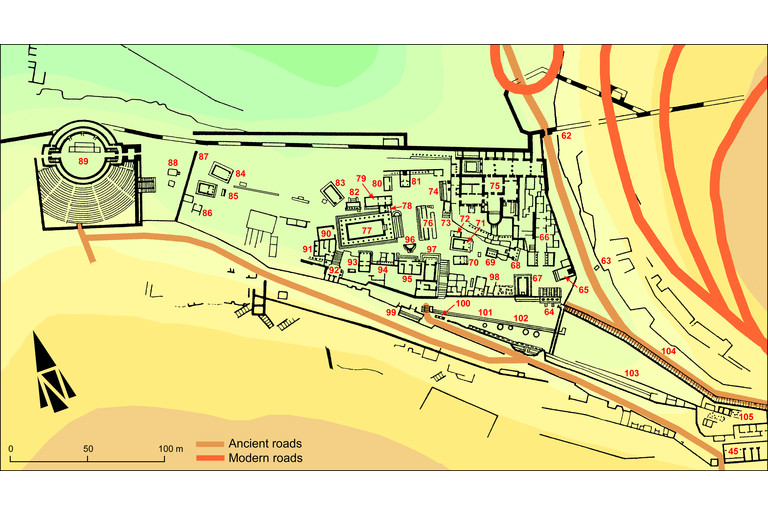Dedication of the Propylaeum
IGCyr098200
Trismegistos ID: 738499
Source Description
Repository
Cyrene Museum, 342+359.
Support
Two adjacent white marble panels recomposed from numerous fragments, the left one (a) nearly complete, (0.705; 0.30;0.065); the right one (b) having lost about one half at right (width 0.34).
Layout
Inscribed in two lines on front face.
Letters
0.10; xi with vertical central stroke, slanting sigma, calice-shaped upsilon.
Place of Origin
Findspot.
Date
Ca. 325 B.C. (prosopography)
Findspot
Found by G. Oliverio in 1932 at Cyrene pleiades; HGL : Sanctuary of Apollo , Greek Propylaeum .
Later recorded Location
Seen by Pugliese Carratelli in 1960 in Shahat : Cyrene Museum .
Last recorded Location
Stones seen by C. Dobias-Lalou in 1976 in the Museum. A cast has been placed in the South architrave of the Greek Propylaeum .
Text constituted from
Transcription from stone (CDL).
Bibliography
SECir Oliverio, G., Pugliese-Carratelli, G., Morelli, D., 1961-1962, Supplemento Epigrafico Cirenaico, Annuario della Scuola Archeologica di Atene e delle Missioni Italiane in Oriente (ASAA)39-40 (= n.s. 23-24), 219-375 - see in bibliography , 129, and Laronde, 1987 Laronde, A., 1987, Cyrène et la Libye hellénistique. Libykai historiai de l’époque républicaine au principat d’Auguste, Paris - see in bibliography , pp. 106-107, 118, 190-191, whence SEG Supplementum Epigraphicum Graecum, Leiden, then Amsterdam, 1923-1971, then 1979- - see in bibliography , 38.1893. Cf. Ensoli in Bonacasa-Ensoli, 2000 Bonacasa, N., Ensoli, S., et al. (eds.), 2000, Cirene, Centri e monumenti dell'antichità, Milano - see in bibliography , p. 128 with further bibliography at p. 218; Luni, 2014 Luni, M., 2014, Attività di Carlo Anti, Luigi Pernier e Gaspare Oliverio (1923-1938), in M. Luni (ed.), La scoperta di Cirene. Un secolo di scavi, 1913-2013, Monografie di archeologia libica37, Cirene Atene d'Africa8, Roma, 123-156 - see in bibliography , pp. 135-141.
Apparatus
Laronde, 1987 Laronde, A., 1987, Cyrène et la Libye hellénistique. Libykai historiai de l’époque républicaine au principat d’Auguste, Paris - see in bibliography Εὐ[κλείδα] : SECir Oliverio, G., Pugliese-Carratelli, G., Morelli, D., 1961-1962, Supplemento Epigrafico Cirenaico, Annuario della Scuola Archeologica di Atene e delle Missioni Italiane in Oriente (ASAA)39-40 (= n.s. 23-24), 219-375 - see in bibliography Εὐ[---]
French translation
Praxiadas fils d'Eukleidas a consacré (ce monument), pendant sa prêtrise.
English translation
Praxiadas son of Eukleidas dedicated (this monument) while being priest.
Italian translation
Praxiadas figlio di Eukleidas ha dedicato (questo monumento) quando era sacerdote.
Commentary
At SECir Oliverio, G., Pugliese-Carratelli, G., Morelli, D., 1961-1962, Supplemento Epigrafico Cirenaico, Annuario della Scuola Archeologica di Atene e delle Missioni Italiane in Oriente (ASAA)39-40 (= n.s. 23-24), 219-375 - see in bibliography , Pugliese Carratelli cited part of the then unpublished 'Report of excavations during summer 1933' in posession of the Antiquities Department of Cyrene with the following description: «Tempio di Apollo. Propilei preromani che il sacerdote Praxiade figlio di Eu--- offrì ad Apollo (…) Nel mezzo dell' architrave era incastrata la lastra di marmo iscritta, che ricorda Praxiade, rinvenuta in numerosi frammenti». In fact, before having identified the function of the building, Oliverio had already discovered the fragmentary inscription in 1932, as the recent publication of the series of Reports demonstrates (see Luni, 2014 Luni, M., 2014, Attività di Carlo Anti, Luigi Pernier e Gaspare Oliverio (1923-1938), in M. Luni (ed.), La scoperta di Cirene. Un secolo di scavi, 1913-2013, Monografie di archeologia libica37, Cirene Atene d'Africa8, Roma, 123-156 - see in bibliography , p. 135 for 1932 and p. 141 for 1933).
Laronde, 1987 Laronde, A., 1987, Cyrène et la Libye hellénistique. Libykai historiai de l’époque républicaine au principat d’Auguste, Paris - see in bibliography , pp. 107, 191 has convincingly dated the inscription at the beginning of the fourth quarter of the fourth century B.C. He has also argued that his proposed restoration of the father's name fitted exactly the space available at line 1, allowing to place this priest into a well-known family.
A cast of the inscription has been inserted into the Propylaeum, restored in a status dated with archaeological arguments at the beginning of the third century.
Both opinions are not irreconciliable if we accept the idea that Praxiadas' benefaction did not happen at the ultimate stage of elaboration of the passage between the Upper Terrace and the Sanctuary proper, the more so that the restored placement of the dedication is too high to let it be easily readable.
Creative Commons Attributions-NonCommercial 4.0 International License.
All citation, reuse or distribution of this work must contain a link back to DOI: http://doi.org/10.6092/UNIBO/IGCYRGVCYR and the filename (IGCyr000000 or GVCyr000), as well as the year of consultation.
